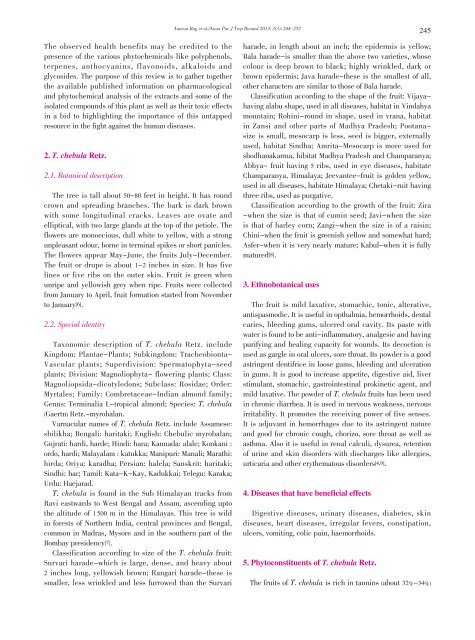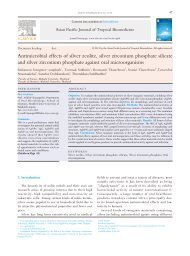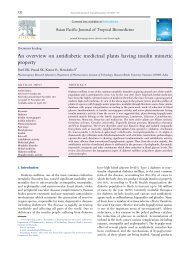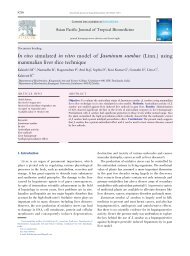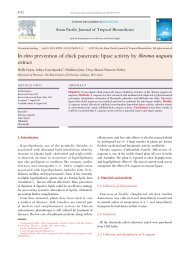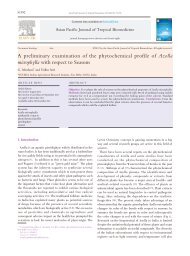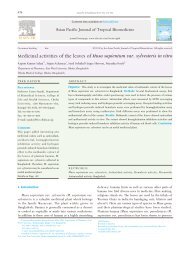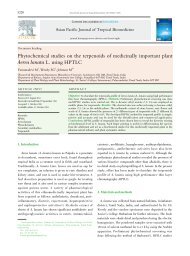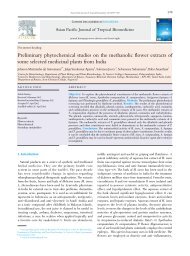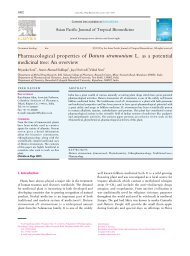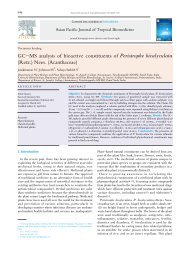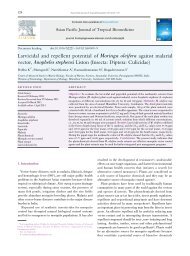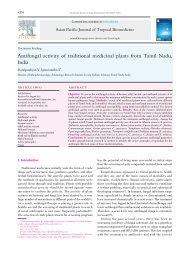Therapeutic potential of Terminalia chebula Retz ... - Apjtb.com
Therapeutic potential of Terminalia chebula Retz ... - Apjtb.com
Therapeutic potential of Terminalia chebula Retz ... - Apjtb.com
You also want an ePaper? Increase the reach of your titles
YUMPU automatically turns print PDFs into web optimized ePapers that Google loves.
The observed health benefits may be credited to the<br />
presence <strong>of</strong> the various phytochemicals like polyphenols,<br />
terpenes, anthocyanins, flavonoids, alkaloids and<br />
glycosides. The purpose <strong>of</strong> this review is to gather together<br />
the available published information on pharmacological<br />
and phytochemical analysis <strong>of</strong> the extracts and some <strong>of</strong> the<br />
isolated <strong>com</strong>pounds <strong>of</strong> this plant as well as their toxic effects<br />
in a bid to highlighting the importance <strong>of</strong> this untapped<br />
resource in the fight against the human diseases.<br />
2. T. <strong>chebula</strong> <strong>Retz</strong>.<br />
2.1. Botanical description<br />
The tree is tall about 50-80 feet in height. It has round<br />
crown and spreading branches. The bark is dark brown<br />
with some longitudinal cracks. Leaves are ovate and<br />
elliptical, with two large glands at the top <strong>of</strong> the petiole. The<br />
flowers are monoecious, dull white to yellow, with a strong<br />
unpleasant odour, borne in terminal spikes or short panicles.<br />
The flowers appear May-June, the fruits July-December.<br />
The fruit or drupe is about 1-2 inches in size. It has five<br />
lines or five ribs on the outer skin. Fruit is green when<br />
unripe and yellowish grey when ripe. Fruits were collected<br />
from January to April, fruit formation started from November<br />
to January[6].<br />
2.2. Special identity<br />
Taxonomic description <strong>of</strong> T. <strong>chebula</strong> <strong>Retz</strong>. include<br />
Kingdom: Plantae-Plants; Subkingdom: Tracheobionta-<br />
Vascular plants; Superdivision: Spermatophyta-seed<br />
plants; Division: Magnoliophyta- flowering plants; Class:<br />
Magnoliopsida-dicotyledons; Subclass: Rosidae; Order:<br />
Myrtales; Family: Combretaceae-Indian almond family;<br />
Genus: <strong>Terminalia</strong> L-tropical almond; Species: T. <strong>chebula</strong><br />
(Gaertn) <strong>Retz</strong>.-myrobalan.<br />
Varnacular names <strong>of</strong> T. <strong>chebula</strong> <strong>Retz</strong>. include Assamese:<br />
shilikha; Bengali: haritaki; English: Chebulic myrobalan;<br />
Gujrati: hardi, harde; Hindi: hara; Kannada: alale; Konkani :<br />
ordo, hardi; Malayalam : katukka; Manipuri: Manali; Marathi:<br />
hirda; Oriya: karadha; Persian: halela; Sanskrit: haritaki;<br />
Sindhi: har; Tamil: Kata-K-Kay, Kadukkai; Telegu: Karaka;<br />
Urdu: Haejarad.<br />
T. <strong>chebula</strong> is found in the Sub Himalayan tracks from<br />
Ravi eastwards to West Bengal and Assam, ascending upto<br />
the altitude <strong>of</strong> 1 500 m in the Himalayas. This tree is wild<br />
in forests <strong>of</strong> Northern India, central provinces and Bengal,<br />
<strong>com</strong>mon in Madras, Mysore and in the southern part <strong>of</strong> the<br />
Bombay presidency[7].<br />
Classification according to size <strong>of</strong> the T. <strong>chebula</strong> fruit:<br />
Survari harade-which is large, dense, and heavy about<br />
2 inches long, yellowish brown; Rangari harade-these is<br />
smaller, less wrinkled and less furrowed than the Survari<br />
Anwesa Bag et al./Asian Pac J Trop Biomed 2013; 3(3): 244-252 245<br />
harade, in length about an inch; the epidermis is yellow;<br />
Bala harade-is smaller than the above two varieties, whose<br />
colour is deep brown to black; highly wrinkled, dark or<br />
brown epidermis; Java harade-these is the smallest <strong>of</strong> all,<br />
other characters are similar to those <strong>of</strong> Bala harade.<br />
Classification according to the shape <strong>of</strong> the fruit: Vijayahaving<br />
alabu shape, used in all diseases, habitat in Vindahya<br />
mountain; Rohini-round in shape, used in vrana, habitat<br />
in Zansi and other parts <strong>of</strong> Madhya Pradesh; Pootana-<br />
size is small, mesocarp is less, seed is bigger, externally<br />
used, habitat Sindha; Amrita-Mesocarp is more used for<br />
shodhanakarma, hibitat Madhya Pradesh and Champaranya;<br />
Abhya- fruit having 5 ribs, used in eye diseases, habitate<br />
Champaranya, Himalaya; Jeevantee-fruit is golden yellow,<br />
used in all diseases, habitate Himalaya; Chetaki-ruit having<br />
three ribs, used as purgative.<br />
Classification according to the growth <strong>of</strong> the fruit: Zira<br />
-when the size is that <strong>of</strong> cumin seed; Javi-when the size<br />
is that <strong>of</strong> barley corn; Zangi-when the size is <strong>of</strong> a raisin;<br />
Chini-when the fruit is greenish yellow and somewhat hard;<br />
Asfer-when it is very nearly mature; Kabul-when it is fully<br />
matured[8].<br />
3. Ethnobotanical uses<br />
The fruit is mild laxative, stomachic, tonic, alterative,<br />
antispasmodic. It is useful in opthalmia, hemorrhoids, dental<br />
caries, bleeding gums, ulcered oral cavity. Its paste with<br />
water is found to be anti-inflammatory, analgesic and having<br />
purifying and healing capacity for wounds. Its decoction is<br />
used as gargle in oral ulcers, sore throat. Its powder is a good<br />
astringent dentifrice in loose gums, bleeding and ulceration<br />
in gums. It is good to increase appetite, digestive aid, liver<br />
stimulant, stomachic, gastrointestinal prokinetic agent, and<br />
mild laxative. The powder <strong>of</strong> T. <strong>chebula</strong> fruits has been used<br />
in chronic diarrhea. It is used in nervous weakness, nervous<br />
irritability. It promotes the receiving power <strong>of</strong> five senses.<br />
It is adjuvant in hemorrhages due to its astringent nature<br />
and good for chronic cough, chorizo, sore throat as well as<br />
asthma. Also it is useful in renal calculi, dysurea, retention<br />
<strong>of</strong> urine and skin disorders with discharges like allergies,<br />
urticaria and other erythematous disorders[4,9].<br />
4. Diseases that have beneficial effects<br />
Digestive diseases, urinary diseases, diabetes, skin<br />
diseases, heart diseases, irregular fevers, constipation,<br />
ulcers, vomiting, colic pain, haemorrhoids.<br />
5. Phytoconstituents <strong>of</strong> T. <strong>chebula</strong> <strong>Retz</strong>.<br />
The fruits <strong>of</strong> T. <strong>chebula</strong> is rich in tannins (about 32%-34%)


